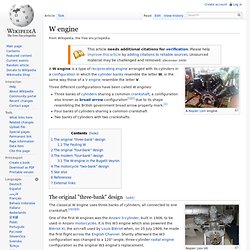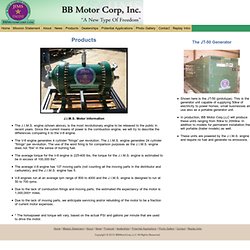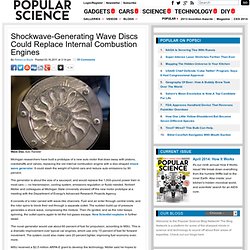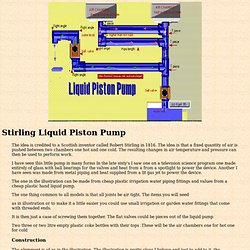

W engine. A W engine is a type of reciprocating engine arranged with its cylinders in a configuration in which the cylinder banks resemble the letter W, in the same way those of a V engine resemble the letter V.

Three different configurations have been called W engines: The original "three-bank" design[edit] Napier Lion VII The classical W engine uses three banks of cylinders, all connected to one crankshaft.[2][3][4] One of the first W engines was the Anzani 3-cylinder, built in 1906, to be used in Anzani motorcycles. A three-bank W12 design was also pursued by Audi, which later abandoned the project. Video: Is Steve Durnin's D-Drive the holy grail of infinitely variable transmissions? Ready for a bit of a mental mechanical challenge?

Try your hand at understanding how the D-Drive works. Steve Durnin's ingenious new gearbox design is infinitely variable - that is, with your motor running at a constant speed, the D-Drive transmission can smoothly transition from top gear all the way through neutral and into reverse. It doesn't need a clutch, it doesn't use any friction drive components, and the power is always transmitted through strong, reliable gear teeth.
In fact, it's a potential revolution in transmission technology - it could be pretty much the holy grail of gearboxes... if only it wasn't so diabolically hard to explain. We flew to Australia's Gold Coast to take a close look at the D-Drive - and it looks to us like Durnin has pulled a rabbit out of his hat. View all. Urine Powered Generator Produces Electricity For 6 Hours on 1 Liter of Pee: Power Your Home With Waste. Imagine powering your home with waste bi-products.

You could essentially power you home with pee. Adult human being produces 1-2 liters of urine per day. 1 liter is enough to power a small generator for 6 hours. How do we know this? A 14 year old girl and her friends from Nigeria, Africa created a system that separates the hydrogen and oxygen in urine, purifies the hydrogen and uses it to power a generator. The amount of electricity produced is not shown, but judging from the size of the generator it’s probably at least a few hundred Watts. “…The Ohio University scientists who developed the urine technology found that attaching hydrogen to nitrogen in urine allowed it to be stored without the strict requirements of ordinary hydrogen, and allowed it to be released with less electricity (0.037 volts versus 1.23 volts needed for water)….”
Via: Keep in mind this is only using 1 liter of pee for 6 hours. Slam Valve Motor; efficient steam engines for residential solar thermal electric power or for plug hybrid vehicles. The flooded tube boiler converts heat to steam and emulsion into useable lubrication for the steam engine. Sediment settles out. Slam Valve Motor, supplying efficient steam engines for homeowners and professional solar installers.

Angel Labs. Products. J.I.M.S.

Motor Information. FLUX THRUSTER. Shockwave-Generating Wave Discs Could Replace Internal Combustion Engines. Michigan researchers have built a prototype of a new auto motor that does away with pistons, crankshafts and valves, replacing the old internal combustion engine with a disc-shaped shock wave generator.

It could slash the weight of hybrid cars and reduce auto emissions by 90 percent. The generator is about the size of a saucepot, and would replace the 1,000-pound power train in most cars — no transmission, cooling system, emissions regulation or fluids needed. Norbert Müller and colleagues at Michigan State University showed off the new motor prototype at a meeting with the Department of Energy's Advanced Research Projects Agency.
It consists of a rotor carved with wave-like channels. Fuel and air enter through central inlets, and the rotor spins to block their exit through a separate outlet. The novel generator would use about 60 percent of fuel for propulsion, according to MSU. MSU received a $2.5 million ARPA-E grant to develop the technology. [Next Big Future] New Simplified Heat Engine Rotary Stirling Engine Project. This site describes a new engine design having these key benefits: It demonstrates the principle of heat engines It is incredibly simple (even for heat engines) You can build it from scratch The new design is substantially simpler than a conventional Stirling engine.

Until now, ultra simple heat engine designs were generally devices that rocked or vibrated but did not rotate. This new design is extremely simple and rotates. (This site assumes familiarity with conventional Stirling engines. Stirling. The idea is credited to a Scottish inventor called Robert Stirling in 1816.

The idea is that a fixed quantity of air is pushed between two chambers one hot and one cold. The resulting changes in air temperature and pressure can then be used to perform work. I have seen this little pump in many forms In the late sixty's I saw one on a television science program one made entirely of glass with ball bearings for the valves and heat from a from a spotlight to power the device. Another I have seen was made from metal piping and heat supplied from a lit gas jet to power the device.